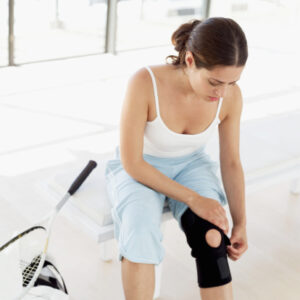Simple Strategies to Reduce Knee Pain
 When your knees hurt, doing knee exercises may be the last thing you want to do… But making smart knee exercise choices just might be the solution to help reduce your knee pain.
When your knees hurt, doing knee exercises may be the last thing you want to do… But making smart knee exercise choices just might be the solution to help reduce your knee pain.
Chondromalacia patella or Patellofemoral syndrome can be a very painful knee condition. The patella (or kneecap) is designed to slide in a groove between the femur and shin bones. If the patella does not track properly in its little groove, or the joint surface and articular cartilage becomes worn or irregular, friction increases. Every time you bend and straighten the knee, you may feel grinding, creaking, or crackling. It might not bother you for a while, so you continue participating in sports and activities that continue to aggravate it. At some point your knees are screaming at you to stop moving, so you finally go to the doctor to find out what’s wrong and how to fix it.
The first thing the doctor will tell you is REST! Avoid ALL activities that jam your patella against the femur with force and grind away at the back of the kneecap. Perhaps you’ll try using a knee brace with a hole cut out to help the knee cap sit where it belongs. A little ice after exercise or at the end of the day, and anti-inflammatory meds to help reduce inflammation that is also keeping the joint aggravated. But seriously, are you giving your body time to heal and stopping all activities that cause you knee pain?
The next step is actually doing the recommended exercise program as instructed by your doctor or physical therapist. Not for a week or two, but for the rest of your life! These exercises (done correctly) should help get the right muscles in balance to keep your kneecap sliding properly in its groove.
What exercises are best for you? Check with your doctor, PT, or health care specialist. “Guessing at the right exercises” or doing exercises incorrectly will only continue to aggravate your knee pain. But a good rule of thumb to start with is that if an exercise or activity hurts your knees, don’t do it!
Reducing Knee Stress
Pressure between the patella and thigh bone is minimal when the knee is straight or only slightly bent. Exercises, sports, and activities that require deep knee bending, jumping and landing, pushing, pulling, heavy weights, stopping and starting can place too much stress on the Patellofemoral joint and patellar tendon.
Here’s why you need to pay attention to the choices you’re making for healthy knees…
The “force” or pressure on the knee joint is 1.8x your body weight with every step when walking on a flat surface. When climbing up stairs it’s 3.5x your weight. Going DOWN stairs – 5x your body weight! And running or landing from a jump the force on the knee can exceed 10 to 12 times your body weight.
Do the math… How many pounds of pressure do you have grinding away on your knee joints with the sports and activities you are participating in? If your knees are 100% healthy, this added stress and strain is not a problem. But with knee pain, is the trauma worth it. Yes knee joints can be replaced, but is that really the road you want to travel?
Here is a list to help you make safe sport choices while you’re working on improving alignment and muscle balance to alleviate symptoms from Chondromalacia Patella and reduce knee pain.
| Sports to Avoid | Sports that Might Not Cause Pain |
Sports that are Safest and Easiest on the Knees |
| Volleyball | Cycling | Swimming |
| Basketball | Baseball | Walking – flat |
| Soccer | Hockey | Cross-Country Skiing |
| Weightlifting (squats/lunges) |
Skiing | (and I have to add Pilates to this list…) |
| Racquetball | Tennis | |
| Squash | ||
| Football | ||
| Distance Running |
From a Pilates training perspective, keep in mind that it’s not just doing exercises for your “knee” that will help you avoid Chondromalacia Patella knee pain. It’s improving your body mechanics and muscle firing patterns for everything from your feet and ankles, all the way up to the hip, pelvis, and back. The knee joint is stuck between the hip and ankle. If the joints above and below are not in proper working order, the knees will take the brunt of the pain. Fix what’s not working properly at the foot, and improve hip mechanics for better gait, and it’s very likely that your knees will start feeling much better.
While Pilates Training is not a “sport,” it is a whole-body conditioning system. Pilates training can be a very valuable asset to help you keep the pressure off your knees and start improving your form and functional movement to get your kneecaps tracking properly to help fix your knee pain. There are many excellent Pilates exercises on the Reformer, Cadillac, Chair, and Barrels, along with the Matwork exercises that can be done safely, and can help improve not only your kneecap tracking, but body alignment and muscle balance for your whole-body.
Generally Speaking, Use these Guidelines for Safe Knee Exercises:
| Exercises to AVOID | Exercises that are OK (if no pain, grinding, or swelling) |
| Lunges | Straight Leg Lifting Exercises |
| Squats | Stationary Bike (seat high, resistance low) |
| Stair-Stepper Machines | Leg Press (knee bend no more than 90 degrees) |
| Leg Extension Machine | Hamstring Curl Machine |
Your Doctor or Physical Therapist will have a specific exercise protocol that they will recommend for you to do to help alleviate the symptoms from your Chondromalacia Patella. Maintaining good form to execute these exercises will make the difference between getting good results, and just going through the motions, or giving up because you think the exercises “don’t work.” If you are not getting the results you want, it’s quite possible that you’re not in the right position to be activating the correct muscles to do the work, or there is more that needs to be addressed (better function for your foot and ankle, and at the hip – to keep the knee joint happy.) Ask questions during therapy, to be sure you’re confident with your knee exercise technique, and once you’re released, consider Pilates as an excellent training method to reinforce healthy knees and good patella tracking to reduce and eliminate Chondromalacia patella knee pain. Most importantly, listen to your body and make smart knee exercise choices to keep your body healthy and pain-free.
Check Out this Knee Cap Exercise to help get you started…
**********


0 Comments